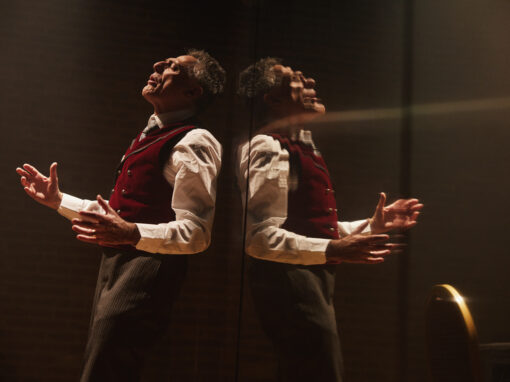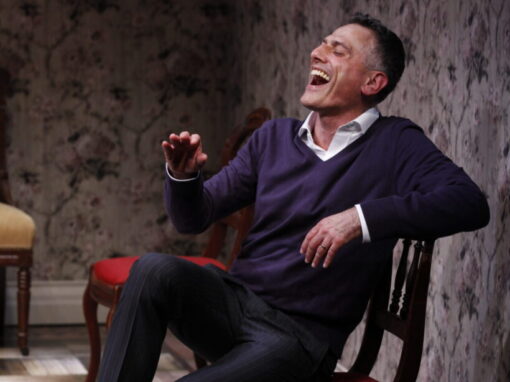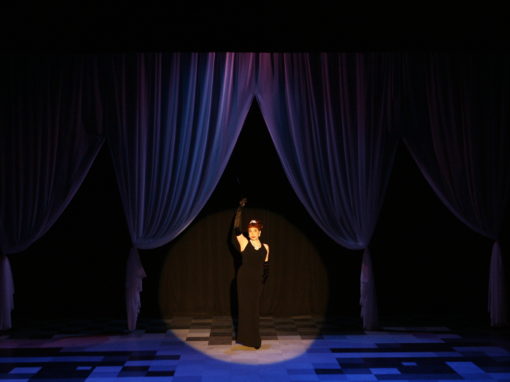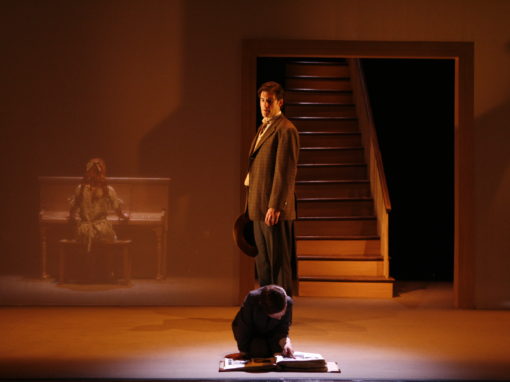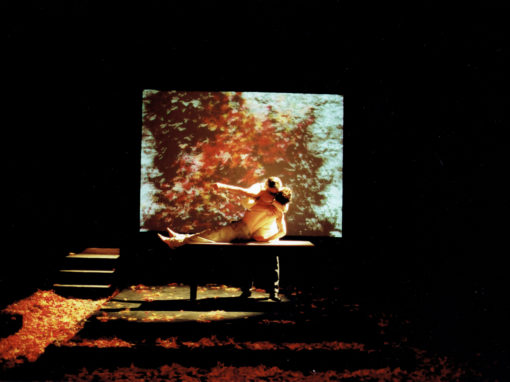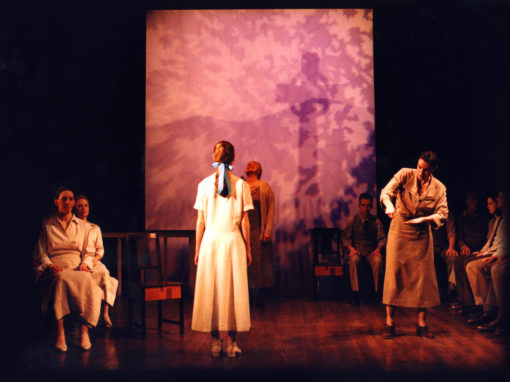Filing Away Memories // by R. Lee Kennedy
A pandemic organization project turned into an unfurling of the past for designer R. Lee Kennedy
While I was home during the last year, I hoped to finally clear out and organize my lighting design production files. I started the project years ago and managed to clear out nearly an entire file drawer, but I had put off going through the twenty-three Transport Group shows that I’ve had the amazing fortune to collaborate on over the last nineteen years. Maybe these seemed too important to disturb.
At the beginning of the pandemic, I think I grieved the loss of theatre creation from my life too much to re-start my file project. Into the summer and fall, I was too depressed to summon the energy. A few weeks ago, I finally waded into my files again. I was feeling brave and was interested to see what remained and what it might conjure.
To be clear, my lighting design files aren’t scrapbooks. They mostly contain drafting, spreadsheets, and lots of numbers. Here and there are handwritten notes and sketches, renderings, clipped images I used as research, an occasional opening night card, a program, or a production postcard. The more recent the production, the fewer items there are, as my production information has in recent years become almost entirely digital.
On my first pass-through, I was saddened that there wasn’t more tangible evidence of work that is so important to me. I felt surely there must be something more somewhere—photos I must have taken or notes I must have recorded. But it didn’t seem to be there. Ultimately as I combed through paper and digital files and thousands of slides and photos, they felt empty compared to the enormous space each production occupies within me.
At least once during tech rehearsal of every production we’ve done, director Jack Cummings wanders over to my table, where I would be at work with intense focus, my assistant on one side, lighting console programmer on the other, and jovially interrupt my lighting designer monologue with some made-up numbers like: “29 at 85, group 11 at 3.” His parody of me (speaking lighting intensity levels to my programmer) would temporarily break the spell of my focus and with a smile, I would summon a retort.
The digits Jack mimicked, like the printed numbers on paperwork in my files that describe every aspect of lighting choices made on decades-old productions are entirely absurd—disconnected from the theatre we were creating in those moments onstage and from the fragments of memories that live in my consciousness.
Bits of these come at random moments, triggered by unknown forces in a jumbled montage like:
Moving a prop end table out of the way for a ladder before an Almost, Maine rehearsal and discovering a narrative in the artifacts left inside by the table’s previous owner: postcards, some polaroid photos, a cassette tape.
After days of incrementally cueing hundreds of lighting changes moment by moment through The Audience, we finally ran “Two Joins Three,” Michael John LaChiusa’s climactic number where our visual focus shifts from one actor grouping to another on every single line and we discovered it was actually going to work!
The amazing magical moment in rehearsal the first time the snow fell during Almost, Maine rehearsal and Tom Kochan’s music played as Kelly McAndrew sat and looked ponderously into the night.
During tech for See Rock City & Other Destinations, when I struggled to figure out how to light Donna Lynne Champlin and Jonathan Hammond high up on the scaffolding for “Niagara Falls” and I grabbed one of the flexible mirrors I brought for the earlier Coney Island funhouse scene and used it to reflect light up onto the actors—and the ensemble of actors joined in with other mirrors to create the watery moving lighting for the moment.
Jack having my somewhat bewildered boyfriend (now partner) David sit in Julia Murney’s chair after a Queen of the Mist preview to look at the lighting and debate whether my all-green lighting choice for the final build in “The Green” worked or whether it evoked Julia’s role in Wicked. (We kept it in.)
In Normal, after so many topsy-turvy scenes in harsh, white, hard-edged light, finally arriving each time at “Write This,” a beautiful warm sepia-toned duet between Polly (Erin Leigh Peck) and her mother Gayla (Barbara Walsh) where each reveal what should be on the daughter’s tombstone should she not survive a life-threatening eating disorder. I teared up every time.
The moment in Michael Rasbury’s amazing immersive sound montage in the finale of Bury the Dead, when the cacophony relentlessly builds to a climax as the soldiers exit the theatre as if by supernatural force, leaving Donna Lynne Champlin, our host, alone onstage. Gives me chills again thinking about it.
A humorous moment during tech for Michael John LaChiusa’s First Lady Suite when actor Mary Testa began talking to me wryly from the stage: “Hey Leeeeee, how’s it going out there…?” and offered an unsolicited solution for how to light the next moment as I sat struggling to figure it out with a terrible cold/fever at the console. (She was right of course.)
During tech for Summer and Smoke when, after trying every version of timing for the final fadeout sequence, lead actor Marin Ireland shared some of her internal process at the end of the play which solved it for us instantly.
The terrifying transition out of the first Prospect Park scene in Crossing Brooklyn: “You’ve come unhinged, You’ve come unglued, You’ve come undone…I know what you did…” and the bungee cords that made up Sandra Goldmark’s scenic design were suddenly set loose by the ensemble to swing in saturated side-light.
Asking Jack during the tech for Normal if he would restage Nicholas Belton as Zack in “Breaking Things” so that he played the entire number in one location, in a four-inch-wide sliver of light. They figured out how to make it work and it was perfect.
The surreal beauty of scenic designer Dane Laffrey’s lawn chair sculpture at the beginning of See Rock City… the first time he assembled it in light and haze. A lot of haze.
For some reason, climbing up on top of the Requiem for William set wall (to access something overhead no doubt), sitting precariously on top, and looking down at the beautiful red and orange autumn leaves on the floor that were part of John Story’s scenic design.
Trying an idea in tech for the revival of Michael John LaChiusa’s Hello Again in the transition out of the scene onboard the Titanic where the actors tapped all of the bare hanging lamps on their exit, making them swing slightly as they barely glowed in the darkness. (It didn’t stay in the show.)
After the Bury the Dead dress rehearsal, putting on actor Matt Sincell’s face camouflage makeup, dressing up, and riding the subway on Halloween night.
A moment in a preview of Picnic when Emily Skinner as Rosemary crossed offstage into a chilly blue light, backlit from my perspective, the exposed wall of the Judson Gym lit behind her by clunky lighting fixtures attached to black steel pipe—I experience a transcendent moment. I was watching the characters in the scene, seeing the actors in the space, and thinking what a gift it was to be able to touch this play with light and illuminate the shared space of actors and audience throughout the entire process.
The “Dreams” section of Three Days to See I sculpted with light scraping across the surface of the New York Theatre Workshop upstage brick wall. A wall it took me several days in the space to realize was actually the convincingly realistic scenic construction from Rent still in place after so many years.
The actors approaching me during a dress rehearsal for The Trial of the Catonsville Nine, to ask if I would leave all of the wiring and transformers that controlled the nine desk lamps visible on top of the newspaper clippings, sculpture of desks, and office furniture that comprised Peiyi Wong’s beautiful set. It was a brilliant idea—I readily agreed!
The gut-wrenching “napalm section” from The Trial of the Catonsville Nine: Eunice Wong as activist Mary Moylan: “As a nurse, my profession is to preserve life…” with Fan Zhang’s enveloping underscoring and sounds of distant wartime bombs exploding.
The scary first time we ran the sequence after “The jury may begin their deliberations…” in The Trial of the Catonsville Nine when the main curtain and roll door come down to enclose the audience and actors together within the Abrons stage and 100,000 watts of light come up to impossibly bright full intensity twelve feet above their heads. The temperature rose instantly about 20 degrees and caused all of the old Abrons light fixtures to smoke as the dust smoldered away.
In The Trial of the Catonsville Nine, David Huynh as the Clerk, kneeling before the file cabinet in a broken shaft of white light before “the taking of the verdict.”
Actually, just about every moment in The Trial of the Catonsville Nine.
So many brilliantly written and comedically timed John Cariani lines from cul-de-sac like “…gotta lime it” and for some reason James Weber’s line “…like we’re slipping, like we’ve slipped, like we’re losing, like we’re lost…” and from Almost, Maine, “Trick it—you gotta trick it.” I hear these and so many more in my head all the time.
Donna Lynne Champlin’s Cora laying with Jack Tartaglia as Sonny at the end of Act I of The Dark at the top of the Stairs, with gauzy shadows crisscrossing the darkness around the stairs behind them.
I could go on but I’ll conclude with:
The devastatingly beautiful final moments of I Remember Mama and Barbara Barrie’s last line as Katrin: “But first and foremost, I remember Mama…” as Barbara Andres’ Mama exits into the growing darkness and the single remaining overhead lamp goes out.
Back in my increasingly empty file cabinet, I eventually got to the Our Town folder. Our Town holds a special status for me. It was our first production as Transport Group and was produced a few months after 9/11. The folder was full of paper to be recycled but also some other items. First, a small packet of gobos that we made to project the constantly shifting shadowy images onto the rectangular backdrop behind the playing area. Some of them were professionally made like the town street silhouette, street signs, gravestones, and a few more. Others, like the profile of distant mountains and a simple roofline, I had cut by hand out of an aluminum baking sheet.
At the back of the file folder was a clear plastic sleeve with a seven-inch swatch of bright blue ribbon. I don’t recall the details but Kathryn Rohe, our costume designer, must have given it to me early in our design process. The Stage Manager, played by 12-year-old Emma Orelove, wore the ribbon in her hair and at the end of the play passed it on to Emily (played by Barbara Andres) before walking upstage toward the backdrop. In design meetings we had dubbed the backdrop “The Mind of God” from the line in the play, and the idea was that as The Stage Manager made her final cross toward it, it would for the first time shift away from the overlapping jumble of gobo projected textures in sepia and amber tones and become the brilliant blue of her ribbon. Like an endless open sky.
Recalling that final transition reminded me of something else—something I wrote after my last day with the show. After a day of searching, I found it. In it, after musing on the emptiness of the post-9/11 New York skyline and the endless cemeteries I passed in a car to Kennedy Airport, I wrote:
The walk from the theatre to my hotel room is layered with colorful shadows. The shapes of everyday things are sketched onto every surface and are colored with a rainbow of city light. In crisscrossing shadows of railings and steel, I see in the darkest places the richest of velvety blue. Near a bright store window, I see pale blue-green sea foam shades like a layer of chalk along the shadow of a pole.
Under a construction walkway it is much darker. Shadows converge so it seems that it is light that intrudes here in amber-pink darts.
Like the street, OUR TOWN is dusted in shades of amber and layered with colorful shadow. The background element that we call “The Mind of God” is an imaginative space. Images shift, change, and blend. Color and texture rise and fall, ebb and flow with the changing emotions of this charged theatrical piece. It is more window than backdrop. It is more expression than location.
Our place and time in this town are so brief. OUR TOWN and our lives are so precious. The opportunities to share, to love, to hold, to lose, and … this consciousness are the most important things.
Do not forget.
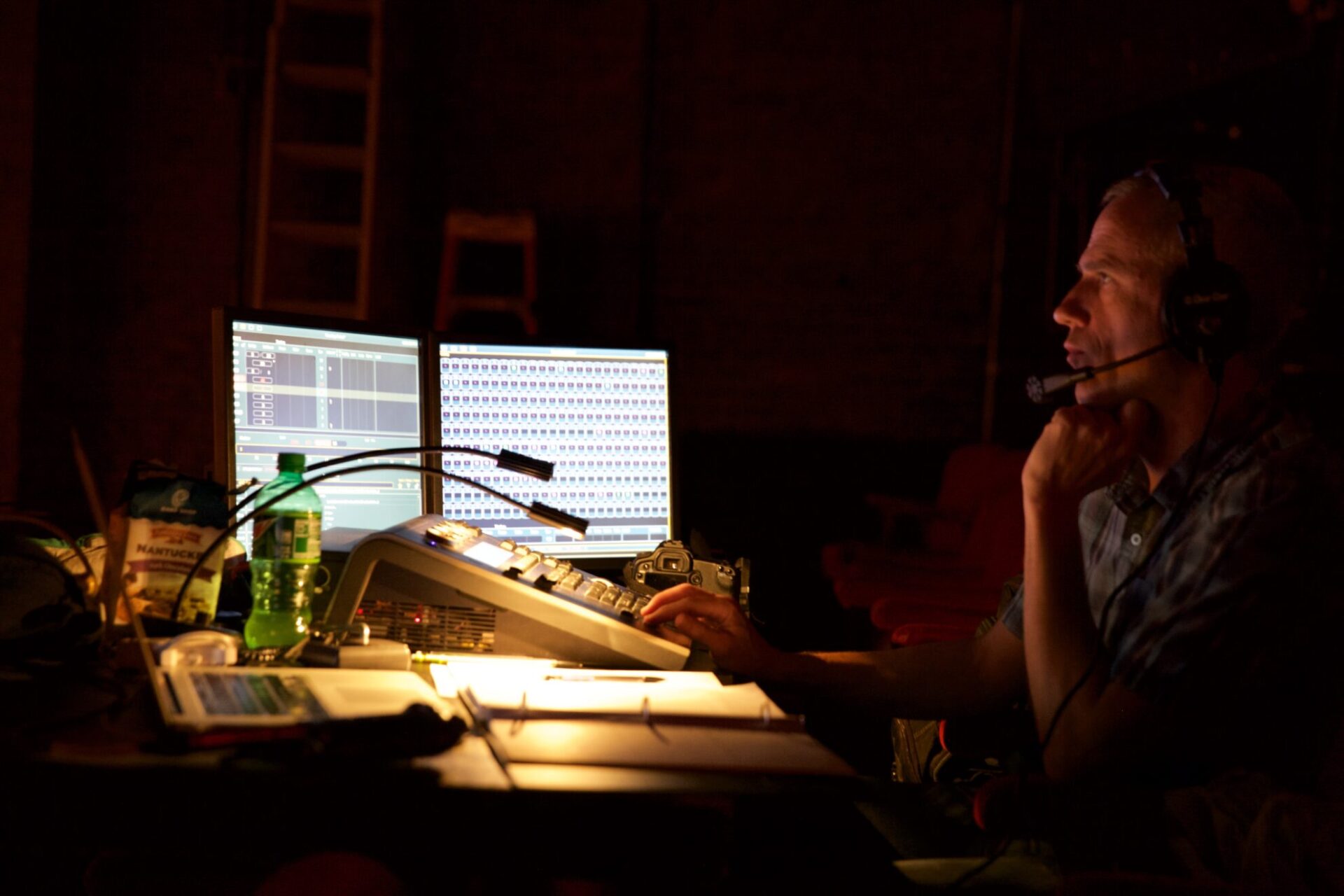
About the author:

Explore Our Past Shows
